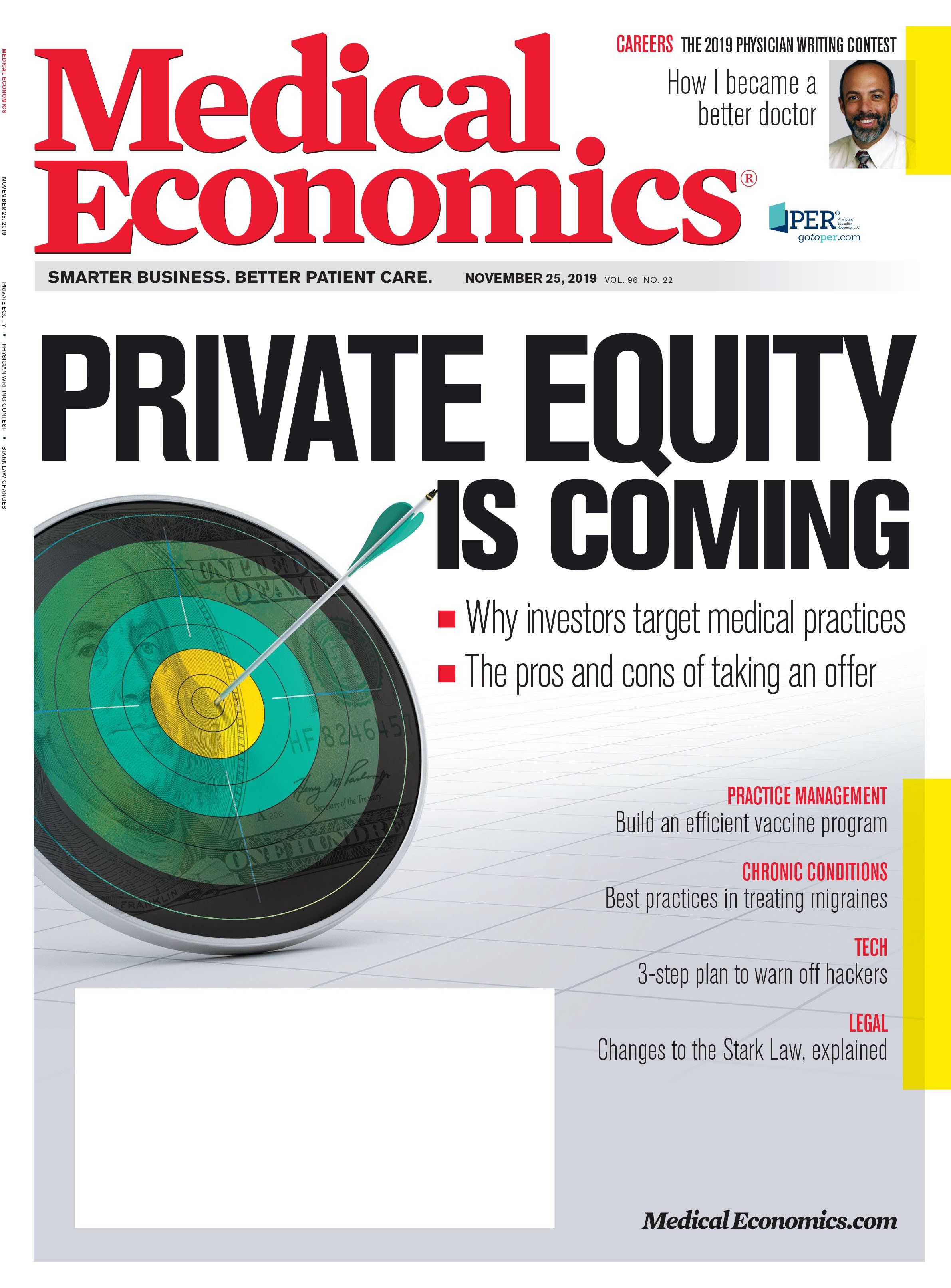Publication
Article
Medical Economics Journal
Private equity in healthcare
Author(s):
What it is, what these firms want, and why your practice might be a target

When it comes to buying medical practices, hospitals and health systems aren’t the only ones writing checks. In recent years, the number of private equity firms looking to purchase practices has continued to increase.
There were $15 billion in deals in 2017, $22.3 billion in 2018 and there is well over $60 billion so far this year, according to the Medical Group Management Association (MGMA). “I don’t see it slowing down,” says Halee Fischer-Wright, MD, president and CEO of MGMA. “Last year, there were 200 private equity deals closed, and as we entered October, we are looking at about 250 to 300 deals this year.”
The first wave of private equity investment hit specialties like orthopedics, dermatology, urology and gastroenterology, where potential profits were highest, but the firms are now expanding their targets. “I do see private equity drifting into primary care practices,” says Fischer-Wright. “They aren’t necessarily looking at buying small ones, but networks so they can control a region and have groups large enough to compete for contracts or drive rates.”
In light of these developments, practices need to understand private equity, both as a possible source of expansion capital and as a potential owner of the local competition.
How private equity works
Private equity firms work by pooling money from investors that they use to buy businesses, create value beyond the purchase price, then sell off the combined portfolio company and return the profits to the investors, says William Spratt Jr., JD, partner, healthcare, for the law firm of Akerman LLP in Miami.
Often, the strategy in healthcare is to either combine multiple practices of the same type to dominate a market, or create a large multispecialty practice.
“A fair number are looking to acquire primary care practices, because they are recognizing that’s where all care starts,” says Spratt, who adds that the shift to value-based care is a major driver in this. “They recognize that primary care practices that have assumed risk-based contracts with third-party payers are attractive targets.”
Spratt explains that if a private equity firm can aggregate, say, 10 primary care clinics in a market, and each has full risk contracts and is good at managing its patient population, that puts the combined company in a good position to negotiate more favorable rates with payers.
The larger patient population also spreads the private equity firm’s risk, because the more patients under their control, the less likely one or two catastrophic cases will affect their quality ratings.
“What a lot of private equity firms like to do is find a ‘platform’ practice-one that has demonstrated the ability to be successful in the market and in its specialty,” says Richard Zall, JD, chair of law firm Proskauer Rose’s healthcare group.
This practice will usually have around a dozen physicians and two to four sites, with at least $5 million to $10 million in earnings before interest, taxes, depreciation and amortization (EBITDA). The firm then adds services to the platform practice or combines it with other practices.
Target platform practices are mostly identified by the equity firms’ business development people. Zall says they attend physician conferences and talk to people in the market to learn who the high-quality practices are and what payers think of them.
Private equity is not a long-term owner in the practice. Physicians with an ownership stake in the acquired practice get an initial buyout plus some equity in the new private-equity controlled company, but investors are looking to get their money back usually in three to five years, says Fischer-Wright. “What we’ve seen is private equity is looking to get three to five times return on investment over that time,” she says.
The pros and cons of selling to private equity firms
An offer from a private equity firm can be appealing to a primary care practice that wants to grow or is struggling to find the capital for the investments needed to succeed in value-based care.
But for the deal to be successful, experts say, physicians must understand the goals of the private equity firm and be comfortable with its leadership team, because the practice will go through many changes.
“When you sell to a private equity firm, you may have a physician or two that sits on the board of the new corporate entity, but it won’t be the physicians driving the major decisions,” says Fischer-Wright. “What the selling physicians often don’t think about is that if the private equity firm is successful and the practice gets sold to a second firm after five years, the physicians won’t have any say in the new company.”
Spratt says most firms will pay 75 percent of the practice’s valuation at closing with physician owners receiving 25 percent in equity in the new holding company that is created. Physicians typically receive the same deal as the private equity firm for their 25 percent when the investors cash out by selling the holding company.
As minority owners, however, they will have little to no say in how the new deal is structured or to whom the practice is sold. Some buyers are health systems and hospitals, so physicians trying to stay independent by selling to private equity may end up being owned by the very entities they were trying to avoid in the first place, experts say.
There may also be a compensation cut for the physician-owners selling the practice. The private equity firm typically compares the median compensation for physicians in that region with what the physicians in the targeted practice are making.
“Traditionally, what happens is physician compensation decreases 30 percent,” says Fischer-Wright. She adds that doctors need to study the numbers to make sure the deal works for them in the long term. “The decrease in compensation may actually wipe out the value of the seven-figure check from private equity over their career.”
If the right private equity partner can be found and physician owners understand the details, it does provide an option for sustainable growth. “To compete in healthcare in 2020, you need that investment in the EHR, the technology platform and more business management,” says Fischer-Wright. “I have yet to meet a physician who wants to spend more time on the business aspect of medicine. For more proactive practices, this is a funding source to become a sustainable practice.”
In most cases, the private equity firm focuses on the business side of medicine and leaves the clinical decisions to the doctors. “For the best private equity firms, they understand that from a clinical perspective, they aren’t professional clinicians,” says Zall. “They are looking for partners on the clinical side that deliver high quality. They know that providing better patient care and delivering higher quality service will make them more successful and more likely to grow.”
Instead, the equity firm usually focuses on streamlining administrative tasks, using economies of scale for purchasing, improving billing practices, brining in new vendors and providing experienced executive leadership.
“There are different models-some are more interested in physician leadership and directed growth while others might be just interested in taking over the platform and have the physicians be employees,” says Zall. “There is not just one size of private equity firm out there.”
Understanding the culture of the private equity firm and how it operates are crucial to the deal succeeding for everyone in the long term, experts say. “Smaller practices don’t think about culture as a major driver of success,” says Fischer-Wright. “Where we’ve seen success, the cultures are complementary. It’s like dating: you really have to get to know your partner.”
Zall advises looking at their track record with similar practices to see if they understand the specialty and the geographic region, and what kind of return on investment they achieved with past deals. The objective measures are important, but so is the interpersonal dynamic.
“Are these people you want to be meeting with early in the morning or late at night and making important decisions with?” says Zall. “Most successful deals have good chemistry. It works more often than you might think it would.”
Does private equity investment affect care quality?
As the number of private equity deals for medical practices increases, some questions have been raised about its potential effect on the quality and delivery of care. Zirui Song, MD, Ph.D., assistant professor of healthcare policy at Harvard Medical School, says that not enough studies have been done to know for sure, but the fears from doctors about private equity’s influence are logical.
“The need to derive a large financial return on investment that private equity firms might face when acquiring medical practices could create pressure to change practice patterns,” says Song. “It could mean increased utilization of certain services, it could change the way patients are diagnosed or treated if those decisions are influenced by the need to generate a financial return.”
Song says he’s heard reports of physicians being concerned about utilization goals or to push certain products. There may be incentives for doctors to use certain services that are costlier or to refer to providers or labs that are also owned by the private equity firm. But he says there is no evidence of this beyond anecdotal accounts, because no studies have been done on the issue.
In some cases, just combining practices can lead to higher insurance premiums for patients, as private equity firms use their leverage to negotiate better rates with payers, and if insurers pass along the price increase. However, physicians may benefit through increased profits, Zall says.
“I think most of the successful private equity firms realize that to be successful, they have to deliver a better product,” he says. “It has to be more accessible, quality at least as good or better than what is in the market, and pricing has to be competitive because consumers are paying more of the bill.
“Some firms may want to do a land grab and do a quick flip, but the better ones realize that if all they are doing is earning money through increased pricing, they will not be successful,” he says.
Song says patients could benefit as well. “We know there is a lot of evidence that the U.S. healthcare system has a substantial amount of low-value care or wasteful care that is delivered,” he says. “To the extent that private equity can help provider practices be more efficient, cut down on unnecessary costs of production, that will help them be more lean in the delivery of healthcare services.”
In the end, physicians have to decide whether the tradeoffs, including some loss of autonomy and compensation to the private equity firm is worth it to them and their patients.
“We should not forget that delivery of healthcare is about the health of the patient and welfare of the patient population,” says Song. “The considerations of private equity ought to take into account the impact on patient well-being.”





















